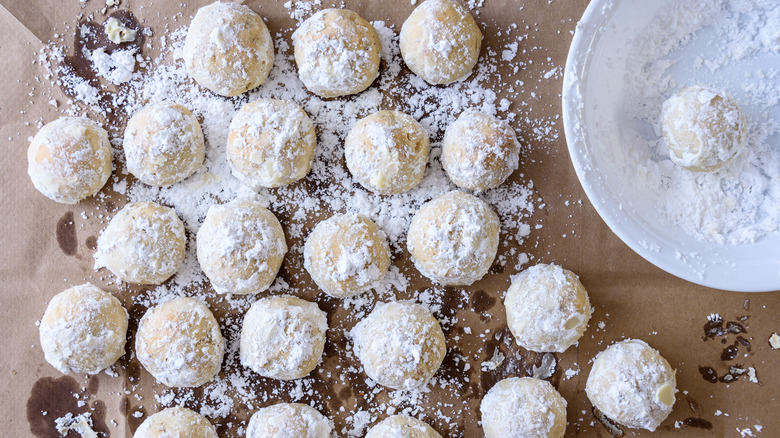No One Really Knows Who Invented Snowball Cookies
Snowball cookies, aka pecan sandies, Russian tea cakes, and Mexican wedding cookies, have origins as mysterious as their multiple names imply. Unlike, say, chocolate chip cookies, which were created at a restaurant called the Toll House in the late 1930s by a woman named Ruth Wakefield, no one can attach a name, date, or location to the first cookies to be made with nuts in the dough and rolled in powdered sugar. Perhaps they were first known in Russia, perhaps in Mexico, or maybe even in Greece as they're fairly similar to a favorite Greek Christmas cookie known as kourabiedes.
In fact, the answer may be all of the above since there's a chance they originated many centuries ago in the Middle East and Arab traders then spread the idea throughout Eastern Europe and the Mediterranean. The Spanish, in turn, took the cookies to Mexico in the 16th century, and it was there that they gained the association with weddings (although they're served for other occasions, as well). The cookie recipe seems to have arrived in the U.S. with immigrants from various countries where this type of cookie is known, which stands to reason as there aren't too many indigenous recipes that involve putzing around with powdered sugar. By the 20th century, the cookies caught on in this country, and things, well, snowballed from there.
When is a snowball not a snowball? When you stick your thumb in it
There are many different variants of the basic snowball cookie theme (or whatever name you want to call them). Many of these revolve around the type of nuts that are used. They range from pecans as in sandies to the almonds typical of kourabiedes to the hazelnuts used in the original Russian tea cakes. They can also be made with walnuts, pistachios, peanuts, or whatever other nuts you have on hand.
You can change up your cookies by using different flavorings, as well — rosewater is popular in Greece, while anise is more of an Italian thing. For the most part, as long as they retain that powdered sugar coating, they can still be called snowballs. Well, unless you change the shape, that is. If you flatten them out and stick your thumb in the middle, you have the makings of an entirely different kind of cookie.
If you create an indent in your unbaked snowball cookie, it's just begging to be filled up with something, usually jam, although lemon curd, Nutella, or Hershey's Kisses will also work. That filled cookie is called a thumbprint, even though more fastidious cooks may use the back of a small spoon for the indenting. Some even refuse the thumbprint label altogether and refer to the cookies as jam-filled snowballs, but even when dusted with powdered sugar "snow," the flattening-out part belies that name since they're no longer ball-shaped.

